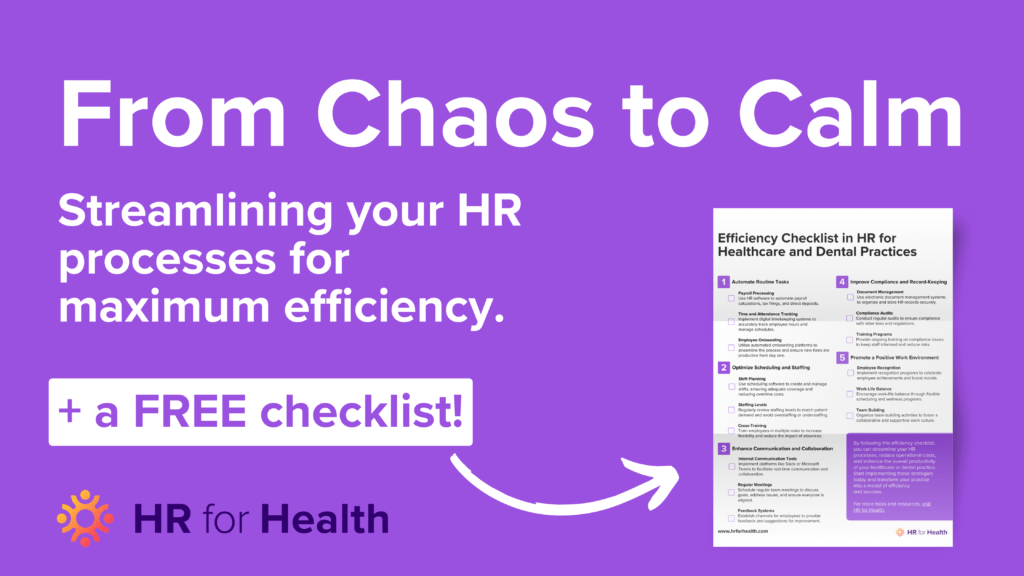In the fast-paced world of healthcare and dental practices, managing HR processes can often feel like navigating through chaos. From handling payroll to maintaining compliance, the demands on practice owners and office managers are immense. However, with the right strategies and tools, you can transform this chaos into calm and achieve maximum efficiency in your HR operations.
Imagine This Scenario
You’re the office manager of a bustling dental practice. Every morning, you face a mountain of paperwork: timesheets to process, payroll discrepancies to resolve, and compliance documentation to update. Your email inbox is overflowing with time-off requests, and your phone is constantly ringing with staff queries. Amidst this chaos, keeping track of employee performance reviews and training schedules seems impossible. The stress is palpable, and your efficiency is plummeting.
Why Streamlining HR Processes Matters
Efficient HR processes are crucial for the success and sustainability of your practice. By optimizing your HR operations, you can:
- Reduce Administrative Overload: Streamlined processes free up time and resources, allowing you to focus on patient care and other critical tasks.
- Enhance Staff Satisfaction: Efficient HR practices foster a more organized and supportive work environment, boosting employee morale and retention.
- Ensure Compliance: Staying ahead of regulatory requirements minimizes risks and protects your practice from potential legal issues.
Key Strategies for Streamlining HR Processes
1. Automate Routine Tasks
Automation is a game-changer when it comes to reducing administrative burdens. Implement HR software that can handle payroll processing, time and attendance tracking, and employee onboarding. By automating these routine tasks, you can ensure accuracy and save valuable time.
2. Optimize Scheduling and Staffing
Effective scheduling is essential for maintaining optimal staffing levels and reducing overtime costs. Use scheduling software to create and manage shifts, ensuring adequate coverage at all times. Additionally, consider cross-training employees to increase flexibility and minimize the impact of absences.
3. Enhance Communication and Collaboration
Clear and efficient communication is the backbone of any successful practice. Implement internal communication tools like Slack or Microsoft Teams to facilitate real-time communication and collaboration among your team. Regular team meetings and feedback systems can also help keep everyone aligned and engaged.
4. Improve Compliance and Record-Keeping
Compliance is a critical aspect of HR management. Use electronic document management systems to organize and store HR records securely. Conduct regular audits to ensure compliance with labor laws and regulations, and provide ongoing training to keep staff informed and reduce risks.
5. Leverage Data for Strategic Decisions
Data-driven HR practices can unlock significant efficiency gains. Use HR analytics to track key metrics such as turnover rates, employee satisfaction, and performance. Predictive analysis can help you anticipate future HR needs and trends, enabling you to make informed strategic decisions.
6. Invest in Employee Development
Continuous training and development are vital for keeping your team motivated and skilled. Offer training programs that enhance employee skills and job satisfaction. Develop clear career paths to reduce turnover and conduct regular performance reviews to provide constructive feedback and set goals.
7. Promote a Positive Work Environment
A positive work environment is essential for maintaining high levels of productivity and morale. Implement recognition programs to celebrate employee achievements and encourage work-life balance through flexible scheduling and wellness programs. Organize team-building activities to foster a collaborative and supportive culture.
Imagine This Scenario
Now, imagine this: As an office manager, you start your day by reviewing automated reports generated overnight. The payroll system has accurately processed all timesheets, and employee onboarding is seamless thanks to your HR software. Compliance documentation is up-to-date and easily accessible. Your team communicates efficiently through internal tools, and regular performance reviews are scheduled automatically. The atmosphere in the office is calm and productive, and you can focus on strategic planning rather than firefighting daily HR issues.
Conclusion
By implementing these strategies, you can transform your HR processes from chaotic to calm, enhancing the overall efficiency of your healthcare or dental practice. Start by downloading our Efficiency Checklist in HR for Healthcare and Dental Practices to guide you through the key steps to streamlining your HR operations.
For more insights and tools, stay tuned to our blog and explore our resources designed to help you achieve HR excellence. Together, we can ensure your practice runs smoothly and efficiently, allowing you to focus on what matters most – providing exceptional care to your patients.


